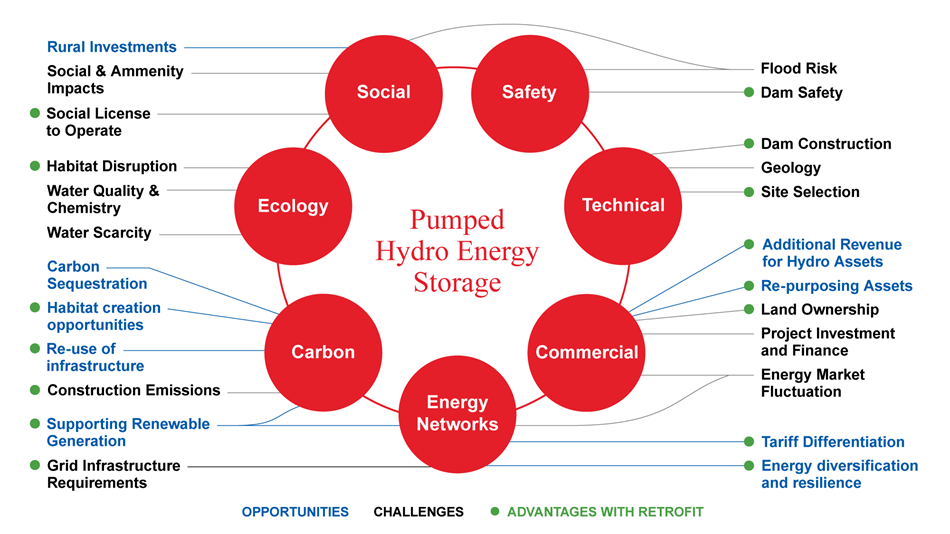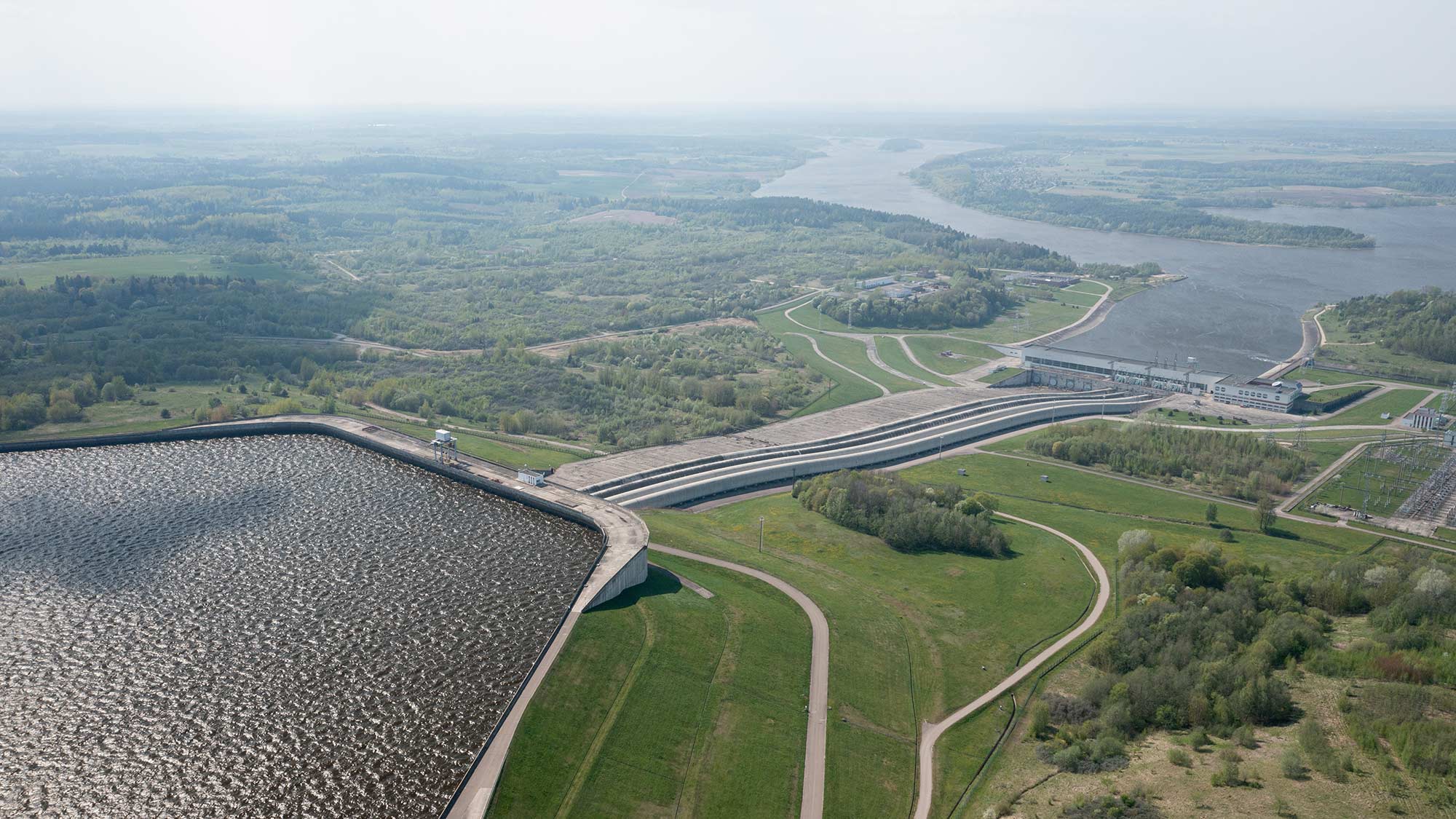One way of overcoming the intermittency of renewable energies such as wind and solar, is pumped hydro energy storage (PHES). Pumped storage isn’t a new idea, but one whose strengths and practicality are becoming more compelling to countries keen to improve the resilience of their energy networks and depend more on renewables. PHES can store energy at the level of regions or countries, for hours or days. To put this in context, Bath County Pumped Storage Station, one of the world’s largest, has a generation capacity of 3GW, and can store 24GWh, while the largest operational battery storage facilities might store 1-2GWh.
The provision of large capacity, long duration storage enhances grid resilience when used in combination with intermittent or highly variable generation. Stored energy can be dispatched when needed, improving grid reliability, especially during periods of high demand or during outages. Energy storage also reduces the need for curtailment of renewable energy during high output–low demand periods. Therefore, it maximises the value of more renewable, low CO2 energy.
As is common in the energy transition, even though this technology is well proven, there are many development hurdles requiring an experienced, multidisciplinary approach and time to overcome. PHES facilities require water storage capacity with appropriate topology, as well as favourable geology, hydrology and proximity to grid infrastructure and demand centres. These requirements restrict the number of potential sites and new PHES opportunities might appear limited – so how might PHES become a bigger part of the energy transition?
From hydroelectric to PHES
At Arup we have been asking ourselves how best to expand the use of PHES and provide much needed long term storage into electricity networks. Across the world there are large numbers of existing hydroelectric assets, but as reported in the IHA’s 2022 Hydropower Status Report, only 12% of that capacity currently offers pumped storage.
However, across the remaining 88% clients and operators are beginning to consider the retrofit of PHES facilities to existing hydroelectric power plants. This might involve adding a new upper reservoir and PHES powerhouse to an existing lower reservoir, or introducing pumping facilities to a series of cascade reservoirs to return flows upstream. The retrofit approach could offer opportunities to increase the value of hydroelectric assets as generation and storage facilities, while the use of existing reservoirs may help limit environmental impacts of PHES and overcome some of the development challenges associated with new infrastructure projects.
We all know that the energy transition needs to accelerate, so anything that offers a potential reduction in energy storage delivery timescale is important to pursue. Not every site will be suitable to accommodate the addition of PHES facilities but this could be an incredibly valuable energy storage opportunity to explore and consider.
Secondarily, some post-industrial sites also offer potential for PHES development. Mine workings or quarries which could be converted or reservoirs used for irrigation and seasonal water storage could be adapted to add PHES. Retrofitting in these locations can alleviate many of the challenges associated with site selection, limit significant land-use changes, and repurpose land which is no longer used for former purposes.
Understanding the opportunities for pumped hydro energy storage
Retrofitting hydroelectric facilities into PHES brings with it opportunities (and challenges) across a number of design and engineering dimensions. This is how we address each project:

Selecting workable sites
As with any major energy infrastructure project, PHES site selection is a complex task. Working with clients on PHES projects across geographies has taught us the importance of considering the social and environmental characteristics of an area as well as the engineering challenges of PHES. You need to have a thorough technical understanding of the topography, geology and flood risks, but developers also need to appreciate the landscape’s character and heritage and have a deep appreciation of local ecology and biodiversity to ensure each facility is as sustainable we can make it. Retrofit assets offer opportunities to utilise sites that may be already adapted to hydro power or industrial usage and bring additional benefits to the local environment and communities.
These assets are long term investments and ensuring they deliver what energy markets, society and the environment need throughout their lifespan is a delicate balance, often reliant on the latest scientific understanding and analysis, such as high-quality climate forecasting and complex energy modelling, to ensure that a site will remain effective and sustainable long into the future.
Our Pumped Hydro Roadmap for the government of New South Wales, Australia, used just these kind of lessons to build a picture of a more sustainable future for a country trying to pivot away from a long reliance on coal.
Nature positive investments
Environmental concerns will always be central to PHES projects as dam construction and new areas of inundation impact on existing habitats, but with meticulous planning and management, schemes could also have a positive impact on local ecology, wildlife and landscapes. Conservation of the local environment and maintaining the existing character and landscape were key considerations for our work on phase 1 of the Leeds Flood Alleviation Scheme, one of the largest of its kind in the UK. And on an even bigger scale, reforestation, new planting and natural earthworks are being used to manage water and reduce flood risk across the coast of Peru as part of our delivery of the Peru Reconstruction with Changes initiative.
Retrofit using mines, quarries, and reservoirs could offer valuable opportunities to improve the local environment – something we achieved at the Bendingo Underground Pumped Hydro facility. Opportunities to create new habitats could be considered as well as investments to ensure net positive biodiversity in the surrounding area. Bringing back a value to a formerly productive site by giving it new purpose, could help to fund site remediation and restoration of habitats and ecology that might otherwise be difficult to achieve.
Lower carbon energy storage
While the construction of major, new PHES assets undeniably implies significant carbon emissions, PHES itself can outperform current other energy storage technologies when viewed from a whole-life operations perspective. Retrofitting existing infrastructure can substantially reduce these emissions, further enhancing the technology’s environmental credentials.
Operational carbon is also valuable. PHES systems can achieve round trip efficiency of up to 82%, which compares very favourably with other large scale energy storage systems, and ensures the energy losses due to transition in and out of storage are kept low.
An investment for the future
True, the initial investment required for PHES can seem daunting, especially when compared with other storage technologies. However, when evaluated from a whole life perspective, PHES emerges as the most cost-effective storage solution and as a result makes up over 90% of the world’s energy storage capacity. PHES facilities are among the most durable energy storage technologies, with lifespans exceeding 80 years. This longevity, combined with the relative stability and low-risk income generated by PHES, should make it an attractive option for long-term investments like pension funds.
Moreover, there’s an inherent flexibility in how PHES functions, which makes it highly adaptable and responsive to energy market dynamics. Operators can pump during off-peak periods when energy prices are low, and generate at times of peak pricing, creating opportunities for substantial returns in addition to potential market incentives for balancing capability and ancillary services.
Accelerating decarbonisation
Finding low emission ways to decarbonise energy is a global priority. Given its many strengths, PHES should play a major and growing role in the ongoing energy transition. By exploring the opportunities to retrofit existing infrastructure, we can not only minimise costs and emissions, but also potentially find productive uses for neglected brownfield sites and bring new economic opportunities to communities. This is a moment to be bold and think creatively about the many opportunities before us.
To discuss a PHES project or potential site, speak to our energy team. [email protected]
Find out more
-
Expertise
Energy
Whether it’s advisory services, energy system integration, or the detailed design of offshore energy structures, we work on behalf of clients across the world to shape transitional and long-term solutions; addressing a wide range of energy sectors and issues - from distributed energy and storage through to expertise in renewable energy.
-
Expertise
Hydrogeology
Arup’s hydrogeologists analyse, control and protect groundwater. These skills help us create better solutions for water catchments, water supply and water flow during underground construction.
 ;
;
